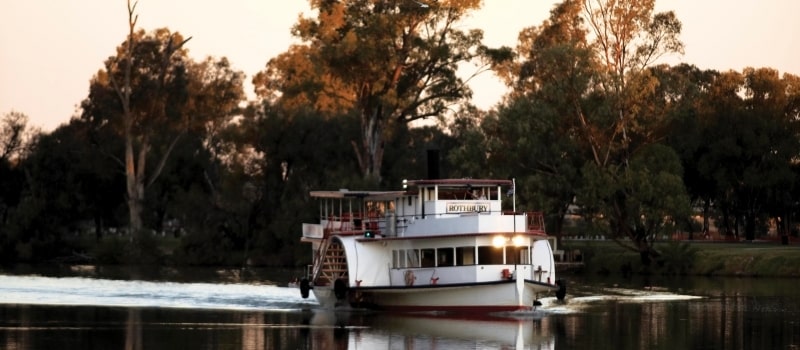Board the historic paddle steamer, PV Rothbury or PV Mundoo for your business event dinner – travel upstream and experience the Murray and riverboat history of Mildura and Wentworth.
Ease out of the day’s business sessions with this scenic evening dinner cruise, boarding just a short walk from your conference venue at the Mildura Grand. Relax with drinks and enjoy the hot and cold carvery buffet which will have everyone going back for more. There’s live entertainment and the ability to network or simply sit back and enjoy the floodlit river bank scenery.
Dinner is included in your return cruise and catered on board by the Mildura Grand, tailored to your specific requirements. The vessel is fully licensed.
Contact us at the Mildura Grand for more information.
P.V. ROTHBURY (1881) – The Rothbury laid idle at Mildura moored at the original “Andersons” slipway for 10 years until she was purchased by Captain Alby Pointon in 1968 for restoration for the Tourism Trade.
During the Rothbury’s seven year restoration, her 55HP Steam Engine and boiler combination was removed for a lower maintenance Gardner Diesel Engine. Hence the current initials P.V. (Paddle Vessel) and not P.S. (Paddle Steamer). However, the Rothbury retains her original wheelhouse and all top deck cabins are the original also. A bar, galley and dining facilities replaced the steam engine area. The Rothbury is 88 feet long, 19 feet wide at the water line with a width of 32 feet across the top of the paddles, weighs 90 tons, and is licensed to carry 175 passengers.

When Captain Charles Sturt first explored the Murray and Darling rivers in 1830, it was immediately obvious that this inland river system had the potential to open up Australia.
Inspired by the use of the Mississippi River in America as a water highway for paddle steamers, Australia’s colonial governments thought a similar transport system might work in Australia.
Before the evolution of steam transport, goods and produce were moved by road, using bullocks and wagons.
The first paddle steamer to successfully traverse the Murray–Darling river system was the PS Mary Ann in 1853. Within a few years paddle steamers had become commonplace, giving rise to a booming industry based on river trade.
Paddle steamers filled a number of roles on the river. Many towed barges laden with wool, while others served as trading vessels. These carried fresh produce, mail and other goods, such as building materials and occasionally even musical instruments, to people living by the river. Paddle steamers also brought news from faraway cities and towns, and their arrival helped connect isolated communities.